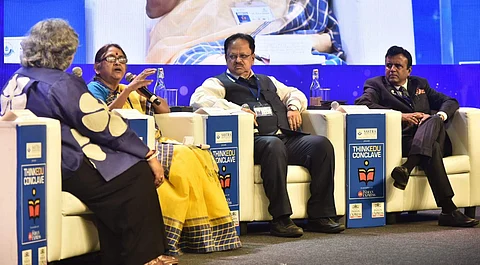

More than 700 medical colleges in India admit 1.10 lakh students but alarmingly 50% of them lack sufficient faculty, said Indian Medical Association President Dr Sharad Kumar Agarwal, at the 13th ThinkEdu Conclave, presented by SASTRA University, on the prevalent issues within the Indian medical education system in Chennai on Thursday.
This revelation sparks concerns about the overall quality of education provided in these medical institutions, pointing to a critical issue that demands immediate attention and reform.
The panel on “The Right Prescription: Revamping Medical Education” on the second day of the conclave included Dr S Sacchidanand, former vice-chancellor of Rajiv Gandhi University of Health Sciences (RGUHS), Dr Sharad Kumar Agarwal, National President, of Indian Medical Association, and Dr Sudha Seshayyan, Director, SASTRA University. It was chaired by senior journalist Kaveree Bamzai.
Speaking at the panel on the second day of the conclave, Dr Sacchidanand pointed out the existing gaps between the medical curriculum and societal requirements. The panellist stressed that the curriculum of medical education in India needs to be tailored to address societal needs.
“There exists a disparity between the curriculum taught in medical colleges and the pressing societal needs. It is imperative to customise our curriculum to address the current challenges faced by the public. Issues such as malnutrition, anaemia in women, leprosy, and tuberculosis persist and demand focused attention in our educational approach,” said Dr Sacchidanand.
Dr Seshayyan highlighted the inadequate access to quality healthcare facilities in rural India and suggested the inclusion of value-based education in the curriculum to motivate students to work in rural setups.
“Managing patients individually in a rural setting differs significantly from supervising cases in a well-established setup. These are the aspects where medical education in India requires enhancement. We must inspire students to engage in rural practice, and there needs to be an inclusion of value-based education within the curriculum to facilitate this,” expressed Dr Seshayyan.
The panelists underscored the importance of skill and competency-based learning in medical education.
“In the past, medical education prioritised knowledge, followed by skills and attitude. However, I propose a reversal of this approach. We should now focus primarily on cultivating the right attitude. This way, we train our students not only in what they know but also in how they interact with patients. Moreover, we aim to produce doctors who are doers, emphasising the importance of training students in skill development,” articulated Dr Sacchidanand, reflecting on the evolving priorities in medical education.
Medical colleges aplenty but grapple with inadequate faculty
The surge in the number of medical colleges in India over the last decade has presented a significant challenge as the faculty ratio has experienced a noteworthy decline during the same period, feared the panelists.
Dr Agarwal addressed the issue, stating – “The biggest problem with medical education is that 50 percent of medical colleges do not have sufficient faculty. We are very happy that we have 700+ medical colleges producing more than 1.10 lakh students, but do these colleges follow any standard operating procedures, do they check all the necessary landmarks?”
The panelists highlighted that the rapid proliferation of medical colleges has led to a shortage of faculty.
“Another reason is that the faculty position in medical colleges is not attractive. MD/MS is the minimum eligibility for these positions, which means it would take at least 9-10 years to get to that level, but the salaries are much less. The National Medical Council has to make the faculty positions more attractive, especially for young doctors,” opined Dr Sacchidanand.
In addition to advocating for a salary hike, Dr Seshayyan emphasised the need to provide medical college faculty with social security and elevated social status.
NEET: Good or bad?
In the ongoing discussions surrounding the National Eligibility cum Entrance Test (NEET), Dr Agarwal expressed his disagreement with the pushback against NEET, particularly in Tamil Nadu. He emphasised that having a centralised medical entrance exam is beneficial for students.
“NEET is a good exam. Initially, every individual had to go from place to place for different exams. We say what is good as per the profession, but we do not know the politics. NEET is a good centralised exam; students have less pressure since they only have to prepare for one exam,” said Dr Agarwal.
While supporting the concept of NEET, he highlighted the need for changes in the counselling process. Dr Agarwal suggested the implementation of unified software for seat allotment in counselling, streamlining the process across states and the central level.
Dr Sacchidanand, shared a similar perspective, stating that NEET serves to save students from distress and creates a level playing field for all aspiring medical professionals.
“But in my personal view, equal importance should also be given to Class 12 board exams. This approach would help eradicate the prevailing coaching culture, ensuring that students do not neglect their board exams,” he added.
